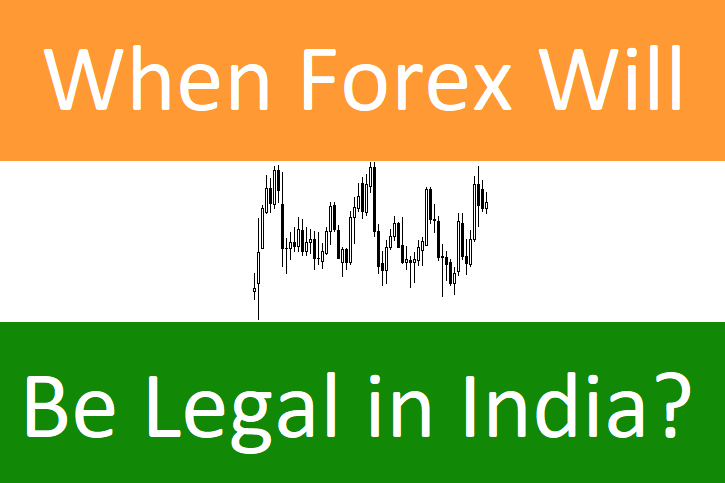
Currency trading is a lucrative profession which can be started with a low investment. However, citizens of several countries across the globe are not permitted to participate in the Forex market. India is one such country where currency trading, exclusive of INR (Indian Rupee) based pairs, is deemed illegal and a

Why Forex trading is illegal in some countries?
To determine when India would allow Forex trading, we should know the reasons for the ban. Exchange of currencies is done primarily to facilitate trade,
So, according to the theory, when free capital convertibility is allowed, there will be an increase in the volatility of the domestic currency. A countryâs economy should be rock solid to withstand such a level of exchange rate volatility. A country should have fiscal (total expenditures minus total receipts other than borrowings) and current account surplus (exports minus imports) to allow free capital convertibility. At the least, the countryâs fiscal and current account deficit should be very low (less than 2% of GDP). If not, the country may not be able to serve its overseas debt, leading to a breakdown of the entire economy.
To avoid adding another layer of risk to the economy, emerging economies control the flow of currencies. By doing so, a country insulates its economy from external shocks. To facilitate trade and keep the economy on a growth track, currency convertibility is generally allowed on current account (exports, imports, and inward remittance) and not on capital account (exchange conversion for investments abroad, purchase of machinery, tools overseas asset purchases, and so on). Once the fiscal and current account situation of a country improves, capital account restrictions are generally removed. Following that, a resident of that country can trade freely in the Forex market.
Indiaâs peculiar case
Before India opened up its economy to foreign investors in 1990, the fiscal deficit stood at 7.6% of GDP. Once the economy was opened up, the fiscal deficit gradually declined. By 2007–2008, Indianâs fiscal deficit was 2.5% of GDP. Overall, there was a transition from gross primary deficit of 4% in 1990–91, to a surplus of 0.9% in 2007–2008. As a preview, in 2007, the country’s central bank, Reserve Bank of India (RBI), relaxed investment norms, under which a resident individual was allowed to invest up to $200,000 in any assets abroad. Further, domestic companies were allowed to invest up to 400% of its net worth abroad.
In the aftermath of the financial crisis, the gross fiscal deficit of India shot up to 6% in 2008–2009, while the primary deficit touched 2.6% of GDP. The country also saw a huge outflow of capital. International credit rating agency Moodyâs cautioned that India is most vulnerable to capital outflows due to reliance on external borrowings. By 2013, when Dr. Raghuram Rajan, winner of Fischer Black prize as the best finance researcher, took charge as the Reserve Bank of Indiaâs 23rd Governor, the fiscal deficit was 4.9% of GDP, while the gross primary deficit was 1.8%. Indian companies had invested $7 billion overseas in 2012–2013. Likewise, individual resident Indians had bought assets worth $1.2 billion in a single year. To build a bullet proof balance sheet, Rajan tightened capital account controls once again. Individuals were no longer allowed to invest more than $75,000 abroad in a financial year.
After Rajan stepped down last year, the new governor continues to toe the same line. The fiscal deficit has dropped to 4% in 2015–2016, while the primary deficit, as a percentage of GDP, has dropped to 0.7%. For the financial year 2017–2018, India is targeting a fiscal deficit of 3%. The current account and fiscal account deficit should remain low. Only then, RBI will remove capital account restrictions.
Indian financial market regulatory bodies
The currency derivatives and equities market in India is regulated by the SEBI and is overseen by the Ministry of Finance and the RBI. The Ministry of Finance monitors the functioning of the currency and equity markets through the Capital Markets Division, which operates under the Department of Economic Affairs. The RBI monitors and controls the market, according to the FEMA act, 1999 (Foreign Exchange Management Act). The RBI also passes necessary legislations to streamline the functioning of the market.
The SEBI is the principal regulatory authority established under the SEBI act, 1992. The SEBI directly monitors the NSE, BSE (Mumbai Stock Exchange), MCX (
When is India likely to lift restrictions on Forex trading?
In an interview with Business Today in 2015, the former RBI Governor Raghuram Rajan had stated that the capital account restrictions would be lifted in stages. Rajan was confident of removing the restrictions in a span 5–10 years, as long as both current and fiscal situation improve. Last year, after Urjit Patel took over as the Governor, a senior spokesperson of the central bank stated that India is not likely to allow full capital convertibility in the next few years. Thus, it can be understood that the residents of India will be unable to exchange their currency freely or participate in the spot Forex market anytime soon. Until full capital account convertibility is allowed, FX trading will remain only a dream for the Indian traders and investors.